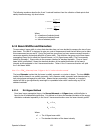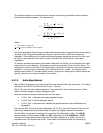
for the Y or Minor axis
2
2/
2
−
−
=
m
w
mm
m
eJJ
Where:
J
= Amplitude at the point m.
J
m
*
= Amplitude at the Gaussian center.
m
= Location of pixel.
m = M location of the Gaussian center.
w
m
* = Width at 1/e² of energy.
Parameters marked with an asterisk (*) are variables fitted.
M
&
m
are not the same as the displayed Centroid Major and Centroid Minor results. However, they
are used to compute those results items.
Note: There is some display limitations when using the Line Gaussian Fit results. If you have set your Reference
Source to either Last Gauss or Auto Gauss, no full frame Gaussian beams will be available to be placed into the
Reference frame buffer. Thus any Beam Display selections that involve the Reference frame will not be updated
nor display any images based upon the Line fit results. Use only Whole Beam fits if you want to use them in
conjunction with the various Beam Display options.
6.16 Deviation of Fit
The Deviation of fit result is a measure of the standard deviation of the beam intensity data from the
fitted Gaussian surface or line. As this result approaches zero the data more nearly matches the
Gaussian surface.
The definition of the Deviation is:
σ
=
−
−
∑
()Zs
n
2
2
Where:
σ
= Standard deviation.
Z
= Pixel intensity.
s
= Gaussian surface intensity.
n
= Number of pixels.
For Line fits there will be a separate Deviation result for each axis.
6.17 Correlation of Fit
The Correlation result gives you a relative value for how well the data matches the fitted Gaussian
surface. The Correlation is useful in the sense that the result approaches one as the fit to the data
Operator’s Manual LBA-PC
Doc. No. 10654-001, Rev 4.10
137


















